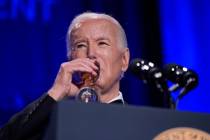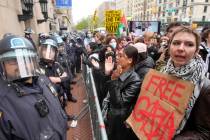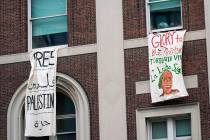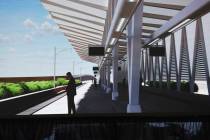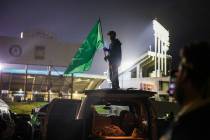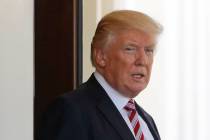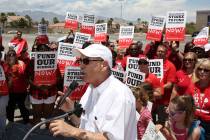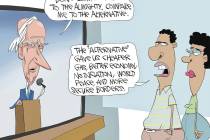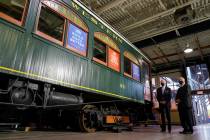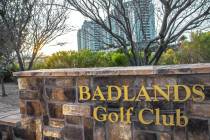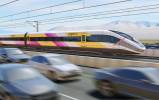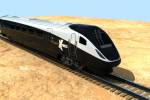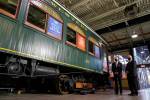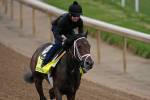Hear them tracks a hummin’?
Las Vegas Mayor Oscar Goodman often describes himself as the happiest mayor in the world, or, if he's feeling really good that day, the happiest mayor in the universe. It's all part of his effort to promote Las Vegas as a great place to visit and to invest.
But don't assume this approach to the mayor's job is original. Back in the 1970s and '80s, while Goodman was working as a defense attorney for mobsters, Las Vegas had a mayor who also believed his main duty was to promote the city. As mayor from 1975 to 1987, Bill Briare traveled the world, spreading the good word about Las Vegas.
In an article printed soon after he became mayor in '75, Briare was quoted as saying that people sometimes mistook him for the president of the chamber of commerce. " 'No, I'm not,' I tell them. It's just that Las Vegas is the most exciting city in the world and, as far as I'm concerned, being mayor of this city is the most exciting job in the world."
Sound familiar?
There's another similarity between Goodman and Briare: Both have championed bold ideas. In Goodman's case, he's long sought to entice a big-league professional sports team to move to Las Vegas and play in a downtown arena. Briare's grand plan was to build a high-speed train to Disneyland.
Briare came up with the idea around 1980. Concerned about the effect of rising oil prices on Las Vegas tourism, Briare proposed building a high-speed train between Las Vegas and Southern California. Later, after reading an article in Popular Science magazine about magnetic levitation technology, Briare thought maglev might be a better way to go.
The train became Briare's passion. Funding was allocated, feasibility studies were commissioned, contractors were retained and potential investors were pitched. By 1983, the pieces seemed to be falling into place to build the train at a cost of $1.8 billion.
It didn't come together the way Briare and others hoped. But a cadre of dedicated supporters continued to work on the project, and their efforts led to the formation of the California-Nevada Super Speed Train Commission in 1988.
A new round of studies followed, and the bi-state commission continued to give shape and texture to its dream of whisking Californians to Las Vegas in 86 minutes. But still, the train did not materialize, as neither state nor federal funding could be secured.
It's time to bring a new character into the story. Back in '75, Briare's opponent in the mayor's race was former Lt. Gov. Harry Reid. The year before, Reid had narrowly lost a bid for the U.S. Senate. He came up short again vs. Briare, losing by 1,315 votes. Reid's political career was over, or so it seemed at the time.
But Reid eventually returned to the political spotlight, first as chairman of the Nevada Gaming Commission, then as a congressman and U.S. senator. Today, as Senate majority leader, Reid is arguably the most powerful person in the nation's legislative branch.
And guess what project has become near and dear to Reid's heart? You got it, the maglev train between Las Vegas and Anaheim, Calif. First, in 2005, Reid helped secure $45 million in federal funds to get the project moving again. Then, last month, he played a role in the inclusion of $8 billion for high-speed rail in President Obama's economic stimulus package.
Prospects have never been brighter. The project hits all the right notes. Its construction would create good jobs amid the worst recession in memory. It uses green technology: no noise, no emissions. It would be extremely reliable, avoiding the headaches of airline delays and highway congestion.
Bruce Aguilera, chairman of the bi-state commission, touts the 99.98 percent reliability of a maglev train operating since 2004 in Shanghai, China. "It operates when the roads are closed, when the airport is closed, when it snows," he says. "There's no down time." What's more, Aguilera says, the Las Vegas-to-Anaheim project is easy to start building quickly because the right of way -- essentially Interstate 15 and California Route 91 -- contains few if any obstacles.
Conservative critics have called the $8 billion a Reid "earmark," but this is not accurate. Reid, along with other Nevada and California officials, certainly hope a portion of the $8 billion goes to the Las Vegas-to-Anaheim project, but the U.S. Department of Transportation will decide how the money is divvied.
Still, it's interesting that Reid may end up being the person most responsible for making Bill Briare's high-speed train a reality.
And by the way, even if the Las Vegas-to-Anaheim project gets a healthy chunk of the stimulus funding, it won't be nearly enough to complete the project. The 1983 cost estimate of $1.8 billion has ballooned over 25 years to at least $12 billion.
Times change, but the goal of boosting Las Vegas tourism remains the primary task for local political leaders. Goodman and Reid have simply picked up where Briare left off.
Geoff Schumacher (gschumacher@reviewjournal.com) is the Review-Journal's director of community publications. His column appears Friday. Read his blog at www.lvrj.com/blogs/schumacher.








